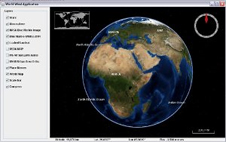December 24, 2009 Vol. 2, Issue 12
The software team at Ames Research Center that created the World Wind Java Software Development Kit won the NASA Inventions and Contributions Board 2009 Software of the Year Award.
NASA’s Inventions and Contributions Board (ICB) recognized project manager Patrick Hogan and his Ames Research Center software team with the 2009 Software of the Year Award for the development of the World Wind Java (WWj) Software Development Kit (SDK) and Web Mapping Services (WMS).
WWj is an open source project that uses satellite data to provide a 3D interactive world viewer featuring applications such as high resolution imagery, surface analytics, terrain profiling, earthquake tracking, and airspace viewing, to name a just few features. WWj is capable of displaying any globe, such as the Moon, if provided with the data.

The Application Template uses imagery data from sources like Blue Marble Next Generation (May 2004) and I Cubed Lansat 15m. Analytic Surface mode represents random altitudes over the Coast of Florida, USA. The application displays stars, atmospheric effect, compass, world map, and scale bar.
At first glance, WWj resembles Google Earth. In 2004, Google bought Keyhole Inc., which developed the geospatial imaging software, and released it under the name Google Earth in October of that year. WWj made its debut nine months earlier. The concurrent development of these similar products was unknown to either group. There is a key difference in their business models: WWj doesn’t restrict the use of its technology. Anyone can tailor it to meet specific needs.
The WWj project began in 2002 under the NASA Learning Technologies Program, which sought to get NASA content into classrooms. NASA houses more data about the Earth than any other organization in the world, and WWj is a way to share that data with the public and academia. The World Wind project welcomes code contributions from the software community and aims to improve the image resolution currently available to the public, making it more comparable to what other virtual globes offer.
Users of WWj include international organizations like the European Space Agency and the Japanese Space Agency as well as the Department of Energy, the Department of Defense, and several Fortune 100 companies.
The Ames software team will formally receive the award at the NASA Project Management Challenge 2010 Conference in February in Galveston, Texas. “To be awarded the Software of the Year is the highest honor we could hope to achieve, aside from providing the infrastructure for geospatial data as recognized by the world,” said NASA WWj Project Manager Patrick Hogan, “I’ve been pinching myself every day since we got the news.”

The Application Template uses imagery data from sources like Blue Marble Next Generation (May 2004) and I Cubed Lansat 15m. Analytic Surface mode represents random altitudes over the Coast of Florida, USA. The application displays stars, atmospheric effect, compass, world map, and scale bar.
“Together, the World Wind SDK client and WMS server provide the infrastructure for government, research, and business communities, as well as education and public outreach, to both deliver and experience information, hopefully increasing our understanding,” said Hogan in an interview for a story that appeared in January. “And it is also true that sometimes we do things just for fun! World Wind technology unlocks the power to make all this happen.”
This is the 16th Software of the Year award presented and sponsored by the Office of the Chief Engineer, the Office of Safety and Mission Assurance, and the Chief Information Office. ICB continues to believe in the importance of recognizing innovative inventions capable of contributing value to the government and the public by furthering space exploration and improving life on Earth.
The ICB grew out of the Space Act of 1958 and has presented millions of dollars to thousands of technological projects dedicated to keeping the nation at the forefront of aerospace engineering. Each year, competitions are held at NASA centers for Invention of the Year and Software of the Year, which produces nominees for the agency-wide competition. The panel determining the winner is comprised of members from each of the centers.





